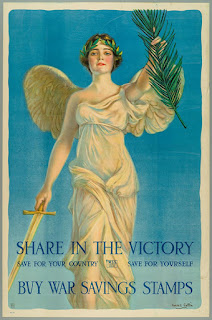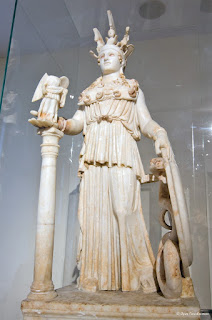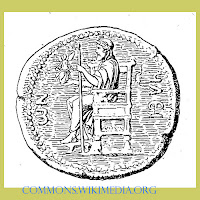 W. Haskell Coffin idealized the appearance of victory as America entered the Great War, as he had done in a wide range of illustrations published in and on American magazines over the first quarter of the 20th Century. He applied his idealized American woman in an image of Nike for a campaign to support the sale of war bonds. A pair of important posters by Coffin helped boost national response to America's entry into the Great War. His "Joan of Arc Saved France," included recently in an exhibition at the BYU Museum of Art ("For Home and Country: Posters and Propaganda from the Great War," curated by K. Hartvigsen) may be better known than Coffin's winged Nike in "Share in the Victory". Coffin's Nike is remarkable for his artistic application.
W. Haskell Coffin idealized the appearance of victory as America entered the Great War, as he had done in a wide range of illustrations published in and on American magazines over the first quarter of the 20th Century. He applied his idealized American woman in an image of Nike for a campaign to support the sale of war bonds. A pair of important posters by Coffin helped boost national response to America's entry into the Great War. His "Joan of Arc Saved France," included recently in an exhibition at the BYU Museum of Art ("For Home and Country: Posters and Propaganda from the Great War," curated by K. Hartvigsen) may be better known than Coffin's winged Nike in "Share in the Victory". Coffin's Nike is remarkable for his artistic application.Iconographically, Coffin's Nike is clearly derived from classical models. The winged figure is draped in a flowing chiton held over her left shoulder leaving her right should bare, precisely as the Winged Nike of Samothrace (Louvre).
The Louvre Nike's drapery is carved to suggest much finer weight fabric, as it blows back so blithely as to show the navel and other anatomical features of the form beneath the carved cloth. Coffin's Nike has a full, if not voluptuous, figure beneath her clothing, even if the overall impression is rather modest. Likewise, the drapery coming forward in three pleats over the left hip on Coffin's Nike is contrived precisely the same as her Samothracian forebear. Both Nikai stride forward with their right foot, unlike another similar Nike at Olympia. Coffin's model for the poster is certainly the sculpture in the Louvre.
The attributes held by Coffin's Nike, a palm frond and a longsword, are an interesting invention. Of course the Nike of Samothrace lacks head and both arms; aside from the wings growing naturally from her shoulders, whatever attributes she held in her hands are missing. She might have held something aloft in one or both of her hands. Since the Louvre Nike's arms are completely missing, it is hard to determine their disposition. The Winged Nike from Olympia, holds her left arm high and her right arm low, as does Coffin's. Her hands missing also, it is unknown whether the Olympia Nike held anything; but her gesture may suggest her pointing, like a herald, to the heavens and to the earth asa messenger might. Classical Nikai often extend laurel wreaths over the head of conquering heroes; thus, for Coffin's Nike to be wearing one herself diverges somewhat from classical iconography. The palm frond extended in her left hand recalls Thomas Brock's Victoria Monument (1901) opposite Buckingham Palace which extends a palm frond in one hand (left) and a wreath in the other.

 Secondary depictions of Phidias' great sculptures indicate that Nikai playing minor roles were preparing to crown victors. A coin stamped at Ellis shows the colossal Zeus sculpture at Olympia extended in his right hand a Nike who held out a laurel wreath. Similarly, the Varvakeion replica of the Phidias' Athena Parthenos likewise held emblems to crown victorious Athens. This Athena is emerging from the battle, not heading toward it. Coffin's decision for his Nike to offer the extended sword seems unprecedented in depictions of Nikai. She enters the fray. Whereas Nike typically comes after the battle has been waged and won, Coffin's new conception offers simultaneously both clean-clad (i.e. easy?) victory and the emblem of peace.
Secondary depictions of Phidias' great sculptures indicate that Nikai playing minor roles were preparing to crown victors. A coin stamped at Ellis shows the colossal Zeus sculpture at Olympia extended in his right hand a Nike who held out a laurel wreath. Similarly, the Varvakeion replica of the Phidias' Athena Parthenos likewise held emblems to crown victorious Athens. This Athena is emerging from the battle, not heading toward it. Coffin's decision for his Nike to offer the extended sword seems unprecedented in depictions of Nikai. She enters the fray. Whereas Nike typically comes after the battle has been waged and won, Coffin's new conception offers simultaneously both clean-clad (i.e. easy?) victory and the emblem of peace.Coffin's conception of Nike is a youthful American beauty. The blue eyes and rosy cheeks feature regularly in the artist's other portrayals of young women on magazine covers such as Redbook, Metropolitan Magazine, and The Saturday Evening Post. His Nike's short bobbed hair further diverges strongly from classical iconography, a feature tending the image more toward strong young women of contemporary US culture than toward a divinity from Ancient Greece. Portraying a strong, lovely girl who might live next door Coffins aims his message at men and women alike. Both women and men can contribute equally to the cause this Nike represents.
— OGCMA.BYU.edu/Nike2.0010_Coffin.htm